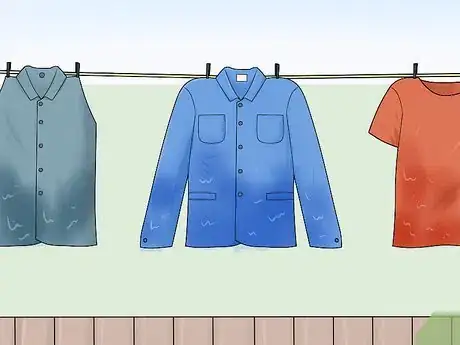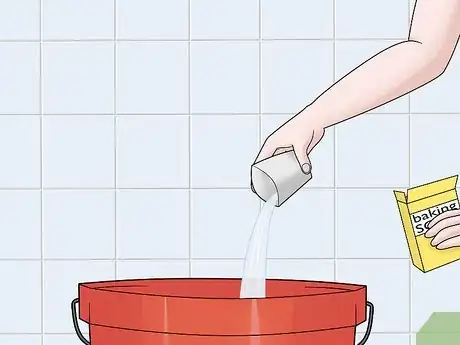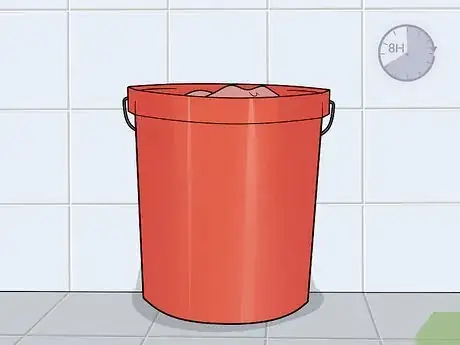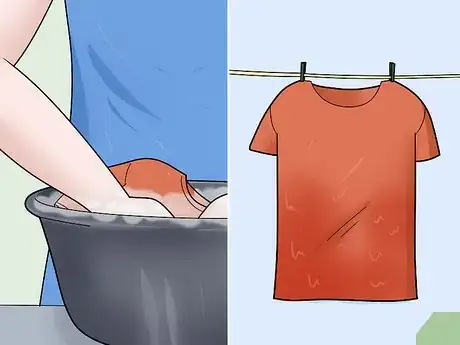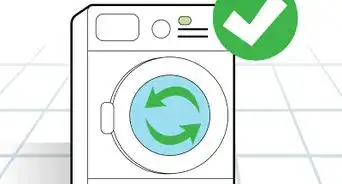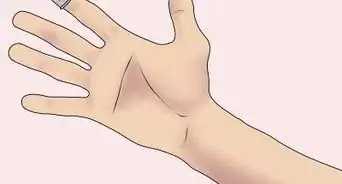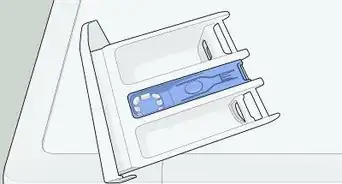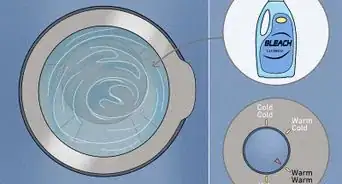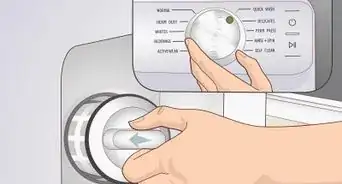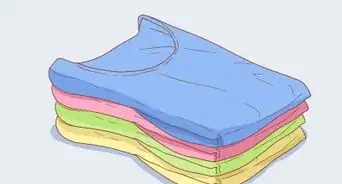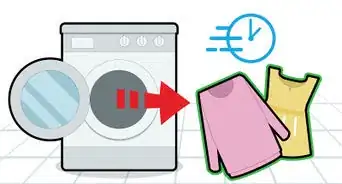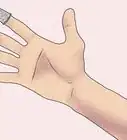This article was co-authored by wikiHow staff writer, Hannah Madden. Hannah Madden is a writer, editor, and artist currently living in Portland, Oregon. In 2018, she graduated from Portland State University with a B.S. in Environmental Studies. Hannah enjoys writing articles about conservation, sustainability, and eco-friendly products. When she isn’t writing, you can find Hannah working on hand embroidery projects and listening to music.
This article has been viewed 77,545 times.
Learn more...
Formaldehyde is a chemical that is often used to preserve clothes and keep them looking nice before you buy them. If your clothing tag says wrinkle-free, stain-free, static-free, or the fabric has a strong chemical smell, it has most likely been saturated with formaldehyde. If you are sensitive to this chemical, it could cause itchy skin, rashes, or even blisters.[1] Air out your clothing for a simple way to get rid of the smell, soak your clothes in baking soda if you have time, or wash your clothes with vinegar for a quick solution.
Steps
Airing out Your Clothing
-
1Choose a well-ventilated area to hang your clothes. A clothesline outside is the best option to hang your clothes up. If you don’t have one, you can open up your doors and windows to give your room some ventilation as the formaldehyde leaves your clothing. If you are hanging your clothes inside, set up a fan to blow the chemicals from the clothing outdoors.[2]
-
2Hang your clothing up on a clothesline or clothing rack. Drape your clothes over a clothesline and attach clothespins to secure them. Or, drape your clothes over a clothing rack and make sure they are centered so that they don’t fall off.[3]
- Don’t hang your clothes in direct sunlight. This could cause them to fade.
Advertisement -
3Allow your clothes to off gas for at least 12 hours. Formaldehyde is a volatile organic compound, or VOC, that will evaporate when it is exposed to air for long enough. Let your clothes sit for at least 12 hours to remove the formaldehyde and any other chemicals that may be in your clothes.[4]
- Leave your clothing to air out longer if you still smell formaldehyde.
Tip: If there are any pesticides or fumigates in your clothes that were sprayed on them during shipment, off gassing will remove those as well.
Soaking in Baking Soda
-
1Fill a bucket or sink with warm water. Choose a bucket, sink, or bathtub that is large enough to hold the clothes you’d like to remove the formaldehyde from. Fill it up about ¾ of the way full with warm water.[5]
-
2Add 1 cup (230 g) of baking soda to the water. Baking soda reduces odor and gently cleans your clothes, so it is suitable for all clothing materials and colors. Pour some baking soda into the warm water and swirl it around gently to mix the ingredients together.[6]
Tip: If you don’t have baking soda, you can use 1 cup (230 g) of Borax instead.
-
3Soak your clothes for 8 hours. Submerge your clothes fully into the water and baking soda mixture. Let the clothes sit overnight or for at least 8 hours to fully remove the formaldehyde.[7]
- If your clothes are especially saturated in formaldehyde, you can soak them for up to 2 days.
-
4Rinse your clothing in cold water and allow it to air dry. Take your clothes out of the baking soda mixture and rinse them out completely with cold water. Wring out the excess water and hang them up outside or in a ventilated area to air dry.[8]
- Air drying will help to get rid of any formaldehyde left over in your clothes.
Washing with Vinegar
-
1Pour 1 cup (240 mL) of white vinegar into the washing machine. White vinegar is a natural deodorizer and can even help to brighten your clothes. Add this ingredient to your washing machine before you start it to combat the formaldehyde in the washer.[9]
- Don’t let your clothes sit in the vinegar. Although it won’t harm your clothes, the acid from the vinegar can be harmful to your washing machine over time.
-
2Wash your clothing using cold water and mild detergent. Cold water helps preserve the clothes while they are in your washer. Use a cold wash cycle and laundry detergent to wash and spin your clothing.[10]
Tip: If you are worried about the detergent not rinsing out all the way, put your clothes through a second rinse cycle without any added detergent or vinegar.
-
3Allow your clothes to air dry. Hang up your clothes on a clothesline outside or in a ventilated area. Let the clothes dry completely before you wear them.[11]
- If you need your clothes dried quickly, put them in the dryer on a low temperature to avoid any leftover formaldehyde from bonding with the fibers.
References
- ↑ https://www.contactderm.org/files/public/Patient%20Handouts/ZZ%20FORMALDEHYDE%20RESIN%20FINISH.pdf
- ↑ https://www.lung.org/our-initiatives/healthy-air/indoor/indoor-air-pollutants/formaldehyde.html
- ↑ https://www.lung.org/our-initiatives/healthy-air/indoor/indoor-air-pollutants/formaldehyde.html
- ↑ http://www.healthyhouseinstitute.com/a-1092-Removing-Odors-from-New-Clothing
- ↑ https://dermnetnz.org/topics/formaldehyde-allergy/
- ↑ https://www.sacfs.asn.au/news/2011/03/03_29_how_to_decontaminate_new_clothing_and_fabrics.htm
- ↑ https://www.sacfs.asn.au/news/2011/03/03_29_how_to_decontaminate_new_clothing_and_fabrics.htm
- ↑ https://www.sacfs.asn.au/news/2011/03/03_29_how_to_decontaminate_new_clothing_and_fabrics.htm
- ↑ https://www.sacfs.asn.au/news/2011/03/03_29_how_to_decontaminate_new_clothing_and_fabrics.htm

